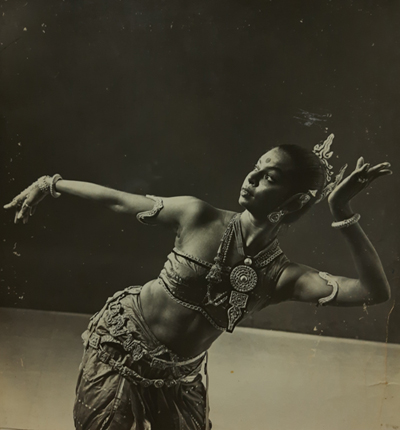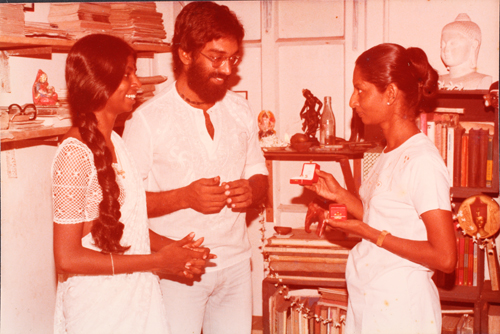A paean to Upeka on her seventieth
View(s):
Sheer artistry: Upeka as Sita in the ballet Dance of Shiva. Photo courtesy Studio Times
My introduction to the Chitrasena world of dance was when I was invited by the maestro to attend a performance of his latest creation (at the time), Kinkini Kolama. Having lived for several years abroad, I had no idea of the endemic dance forms of Sri Lanka except for what I had seen at the Kandy Perahera as a child.
The production was simply stunning to me, with all the elements of theatre-artistry that included the surrealistic opening with a Kavi-kola Karaya accompanied by a dwarf and a stilt-walker and quickly went on to include some characters in traditional masks. The music was haunting, the lighting was near perfect and the choreography and dancing had me watching in awe. I had seen musical and dance theatrical productions in the USA and UK and so had a good idea of what quality productions were all about, so to say I was gob-smacked would have been an understatement.
Then there was Upeka, who played the lead and from the time she appeared, had me transfixed, not only by her beauty, but also by her acting and most of all by her grace and superb dancing. I was smitten by the sheer artistry of the creation that contained all the elements that dance-drama required, as well as an exhibition of all the endemic dance forms of the country in a seamless production of unremitting quality.
This experience was my introduction to Chitrasena, which developed into a relationship that soon included his family. In time I became a frequent visitor to his iconic home that also served as his School of Dance and as a result often watched the daily evening dance practice-sessions. As time passed, I was also involved in assisting in some of the pre-production work that included work on programmes, sets and promotional elements. All this gave me ample opportunities to get to know Upeka and to see the extent of her dedication to her parents’ world of dance. She was tireless in her application to what was required to achieve the finesse she displayed as a dancer and performer and, in spite of some of the setbacks that occurred, like the losing of the Chitrasena home and Dance School, she stood by her parents and, together with the other members of the family, helped with continuing the classes and rehearsals in a variety of rented spaces and at different locations.
Not long after Kinkini Kolama was produced, Upeka got married and had to balance marriage with her commitment to the Dance. This was especially difficult, as her husband was often away from home, occupied with his own career, first as a landscape consultant and later as the National Director and chief administrator of an International NGO. This meant him spending time setting up projects around the country and also visiting projects in Asia and Europe. Fortunately for both of them, he was not only supportive of Upeka’s dedication to her art but also assisted her in whatever way he could.

Family support: Upeka and Cedric with Vajira. Photo courtesy CVDF Archives
In time, as both Chitrasena and Vajira slowed down in their appearances on stage, the productions were centred around Upeka, who led the Dance Company in its tours to several countries, many of which she organized on her own, arranging rehearsals that were supervised by Vajira, with the final programmes approved by Chitrasena. Financing these efforts was no easy task, but somehow, with assistance from those close to her, she managed. In this way, Upeka sustained the Dance Company and kept the Chitrasena/Vajira name and image alive both at home, as well as abroad. The reviews of the performances abroad describe the effect that she and the Company had on foreign audiences and knowledgeable critics. A comprehensive list of the productions and reviews, as well as those members of Royalty and dignitaries she performed for could be seen at https://javajones.wordpress.com/about/
The prime consideration for Upeka, as she closed in on her career as the main dancer of the Dance Company, was passing the mantle to the next generation so that there would be a seamless continuation of the Sri Lankan Dance-Drama tradition conceived and realized by Chitrasena and Vajira. And to this end she was fortunate to have the next generation comprising of Heshma, (also a dancer, who decided to follow in the footsteps of her grandparents) for the creation of new work, choreography and direction, Thaji, who displayed ample promise as the main dancer to take over from her aunt Upeka and Umadanthi, (sister of Thaji) who danced, as well as was developing into a skilled administrator. Together, the three of them, assisted by Upeka and her sister Anjalika, took over the running of the Chitrasena Kalayathanaya so that the dance classes continued without abeyance. Both Chitrasena and Vajira oversaw the progress until the demise of the maestro and Vajira continues to teach and advise.
Upeka’s swansong was in the production of ‘Dancing for the Gods’ (Heshma’s second production with the Dance Company), in a mini-ballet depicting the legend of Kuveni, in 2011, her sixtieth year, after which she continued with her teaching classes and being a mentor to Thaji and other dancers of the Company.
And now, in her twilight years (she celebrated her 70th birthday on May 21), she still continues to stay in condition through daily workouts and spends much of her time in Kalayathanaya-related work.
Upeka was a brilliant exponent of what her parents conceived and produced, not only through her exquisite artistry as a dancer, but also as a faithful disciple of her parents. Long may she continue to inspire and be remembered for her excellence.
In her father’s words:
“My daughter Upeka has all the qualities and attributes of an exceptional dancer. Being a third generation artist and having grown up with the dance she has naturally absorbed it in its widest sense. She is on par of her own amongst the younger generation of artists and is a typical product of the new generation, skilfully blending the traditional style with a more modern interpretation which she has developed into a style uniquely her own. Moreover, she has an extraordinary sense of drama and has proved herself a very dramatic artist as evidenced in her portrayals in Kinkini Kolama and Dance of Shiva. She is also endowed with a keen intelligence and sensitivity which are invaluable assets for an artist.” -Chitrasena – 1986 JJ


